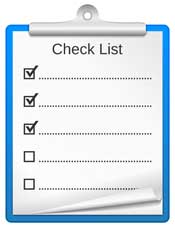 Even the simplest bindery department can be a complicated operation with a mix of post-press machinery, procedures and materials. No matter how well-trained an operator or manager, it's easy to miss something that leads to a mistake. We can all probably recall more than once getting that “uh-oh” feeling after finishing a job. You’d open a box to double-check that you had folded something the right way or kept various lots of a saddle stitched book separate.
Even the simplest bindery department can be a complicated operation with a mix of post-press machinery, procedures and materials. No matter how well-trained an operator or manager, it's easy to miss something that leads to a mistake. We can all probably recall more than once getting that “uh-oh” feeling after finishing a job. You’d open a box to double-check that you had folded something the right way or kept various lots of a saddle stitched book separate.
In The Checklist Manifesto, by surgeon Atul Gawande, he tells the story of how a doctor created a basic checklist in an attempt to prevent infections in the intensive care unit of his hospital. Of course all doctors know full well the required procedures, including basic items such as washing their hands with soap and wearing masks. He asked the nurses in ICU to observe the doctors for a month to record how often they completed each required yet basic step. In more than a third of patients, these highly experienced critical care doctors skipped at least one basic step.
 A checklist procedure was then implemented at this hospital, with startling results. The infection rate they were monitoring went from 11% to zero. The author goes on to talk about similar results in various medical facilities around the world.
A checklist procedure was then implemented at this hospital, with startling results. The infection rate they were monitoring went from 11% to zero. The author goes on to talk about similar results in various medical facilities around the world.
Checklists work. The first thing Captain Sullenberger did when two engines failed on his “Miracle on the Hudson” flight was to pull out the checklist. He successfully landed the crippled plane in the Hudson River. The goal of a checklist is to prevent mistakes from happening, often in the face of pressure or complexity. But the mistakes themselves are usually very basic steps and they are often the same ones made repeatedly.
Here are six ways that checklists can work for your bindery or printing operation.
It’s a safety net for training. Repetition reinforces proper setup technique and equipment operation without requiring a supervisor to shadow an operator after training. Checklists, however, should not be a substitute for training. You wouldn't want your surgeon operating on you or your pilot flying based solely on a checklist. Some training is required! The purpose of the checklist is to keep the user on track, doing exactly what they were carefully trained to do.
Even experienced bindery equipment operators can benefit from checklists when learning a new piece of equipment. Old habits from a previous piece of equipment might prove dangerous or counter-productive on a newer piece of equipment. A checklist will keep the old habits from kicking in.
Quality Assurance. It ensures job specs are followed from beginning to end. Customer requests can be numerous and complicated and a checklist ensures they are adhered to.
Improving Efficiency. When you create a checklist, follow it and modify it, you might soon find there are better ways to do certain tasks. Once you find the ideal method, follow your checklist to accomplish things in an orderly, step by step fashion, insuring that nothing is overlooked.
Improving Communication. Dr. Gawande says checklists can improve communications with items like this: “If X happens, speak to Y.”
Improving Safety. Modern bindery equipment has all sorts of built-in safety features, usually required by OSHA. Despite this, people still get hurt and killed in the printing industry. Where the possibility for injury exists, there should be a required checklist to prevent those mistakes from happening.
Making Decisions. Many decisions can be made in advance. This can be especially helpful in multiple shift operations when managers or customers aren’t available for questions in the middle of the night. A checklist with “If X, then Y” scenarios can keep things moving without those dreaded late night phone calls.
It takes work, but checklists can be created for each machine in the department and for each procedure. They should not be too long or too complicated or else no one will use them. One page is an ideal length. They should also fit the work flow in a sensible way. This simply means you need to create a checklist, use it and revise it until it works smoothly.
In the spirit of things, Dr. Gawande has created his own Checklist for Checklists, courtesy of projectcheck.org, which you can download below. It’s a simple 3-step checklist to guide development, drafting and validation of your own unique checklists. You can easily create your own in Word or Excel or even use a simple online app such as http://printablechecklist.org/.

